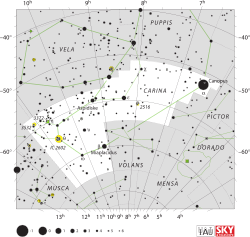l Carinae

| |
| Observation data Epoch J2000.0 Equinox J2000.0 | |
|---|---|
| Constellation | Carina |
| Right ascension | 09h 45m 14.81122s[1] |
| Declination | –62° 30′ 28.4519″[1] |
| Apparent magnitude (V) | 3.39[2] |
| Characteristics | |
| Spectral type | G5 Iab/Ib[3] |
| U−B color index | +0.76[2] |
| B−V color index | +1.03[2] |
| Variable type | Classical Cepheid |
| Astrometry | |
| Radial velocity (Rv) | +3.3[4] km/s |
| Proper motion (μ) | RA: –12.88[1] mas/yr Dec.: +8.19[1] mas/yr |
| Parallax (π) | 2.09 ± 0.29[1] mas |
| Distance | approx. 1,600 ly (approx. 480 pc) |
| Details | |
| Mass | 8.4[3] to 13[5] M☉ |
| Radius | 169±8[6] R☉ |
| Surface gravity (log g) | 1.5[7] cgs |
| Temperature | 5,091[7] K |
| Metallicity [Fe/H] | 0.30[7] dex |
| Age | 33.3±5.9[3] Myr |
| Other designations | |
| Database references | |
| SIMBAD | data |
.jpg)
HD 84810, also known as l Carinae (l Car), is a star in the southern constellation of Carina. It has a mean apparent magnitude of +3.4,[2] making it readily visible to the naked eye and one of the brighter members of Carina. Based upon parallax measurements, it is approximately 1,600 light-years (490 parsecs) from Earth.[1]
From the characteristics of its spectrum, l Carinae has a stellar classification of G5 Iab/Ib.[3] This indicates the star has reached a stage in its evolution where it has expanded to become a supergiant with 169 times the radius of the Sun.[6] As this is a massive star with 8[3]–13[5] times the mass of the Sun, it rapidly burns through its supply of nuclear fuel and has become a supergiant in roughly 33 million years,[3] after spending 15–17 million years as a main sequence star.[5]
l Carinae is classified as a Cepheid variable star and its brightness varies over an amplitude range of 0.725 in magnitude with a long period of 35.560 days. The radial velocity of the star likewise varies by 39 km/s during each pulsation cycle.[8] It has a compact circumstellar envelope that can be discerned using interferometery. The envelope has been resolved at an infrared wavelength of 10μm, showing a radius of 10–100 AU at a mean temperature of 100 K. The material for this envelope was supplied by mass ejected from the central star.[5]
References
- ↑ 1.0 1.1 1.2 1.3 1.4 1.5 van Leeuwen, F. (November 2007), "Validation of the new Hipparcos reduction", Astronomy and Astrophysics 474 (2): 653–664, arXiv:0708.1752, Bibcode:2007A&A...474..653V, doi:10.1051/0004-6361:20078357.
- ↑ 2.0 2.1 2.2 2.3 Madore, B. F. (June 1975), "Photoelectric UBV photometry of Cepheids in the Magellanic Clouds and in the southern Milky Way", Astrophysical Journal Supplement Series 29: 219–284, Bibcode:1975ApJS...29..219M, doi:10.1086/190342.
- ↑ 3.0 3.1 3.2 3.3 3.4 3.5 Tetzlaff, N.; Neuhäuser, R.; Hohle, M. M. (January 2011), "A catalogue of young runaway Hipparcos stars within 3 kpc from the Sun", Monthly Notices of the Royal Astronomical Society 410 (1): 190–200, arXiv:1007.4883, Bibcode:2011MNRAS.410..190T, doi:10.1111/j.1365-2966.2010.17434.x.
- ↑ Evans, D. S. (June 20–24, 1966), Batten, Alan Henry; Heard, John Frederick, eds., "Determination of Radial Velocities and their Applications, Proceedings from IAU Symposium no. 30", Determination of Radial Velocities and their Applications (University of Toronto: International Astronomical Union) 30: 57, Bibcode:1967IAUS...30...57E.
|chapter=ignored (help) - ↑ 5.0 5.1 5.2 5.3 Kervella, P.; Mérand, A.; Gallenne, A. (May 2009), "The circumstellar envelopes of the Cepheids ℓ Carinae and RS Puppis. Comparative study in the infrared with Spitzer, VLT/VISIR, and VLTI/MIDI", Astronomy and Astrophysics 498 (2): 425–443, arXiv:0902.1588, Bibcode:2009A&A...498..425K, doi:10.1051/0004-6361/200811307.
- ↑ 6.0 6.1 Davis, J. et al. (April 2009), "Observations of the pulsation of the Cepheid l Car with the Sydney University Stellar Interferometer", Monthly Notices of the Royal Astronomical Society 394 (3): 1620–1630, arXiv:0812.4791, Bibcode:2009MNRAS.394.1620D, doi:10.1111/j.1365-2966.2009.14433.x.
- ↑ 7.0 7.1 7.2 Luck, R. E. (September 1979), "The chemical compositions of nine southern supergiant stars", Astrophysical Journal, Part 1 232: 797–806, Bibcode:1979ApJ...232..797L, doi:10.1086/157340.
- ↑ Klagyivik, P.; Szabados, L. (September 2009), "Observational studies of Cepheid amplitudes. I. Period-amplitude relationships for Galactic Cepheids and interrelation of amplitudes", Astronomy and Astrophysics 504 (3): 959–972, arXiv:0908.3561, Bibcode:2009A&A...504..959K, doi:10.1051/0004-6361/200811464.
| ||||||||||||||||||||||||||||||||||||||||||||||||||||||||||||||||||||||||||||||